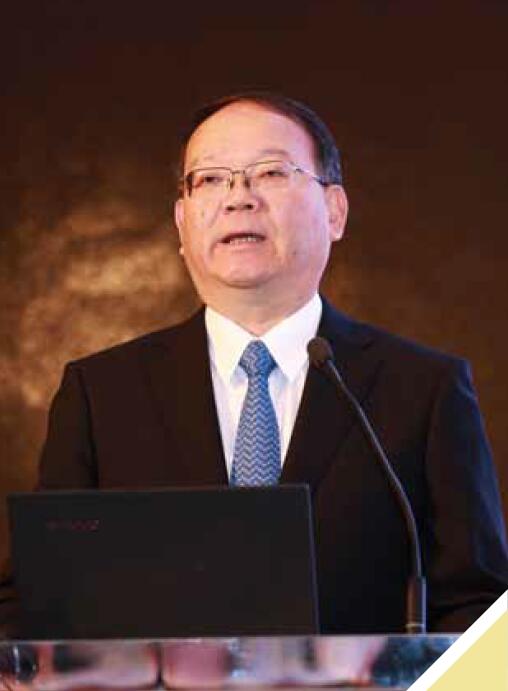The Belt and Road Initiative will Input New Energy into Chinese Textile Industry
Nov 10, 2015 | by
The Belt and Road Initiative will Input New Energy into Chinese Textile Industry
--- Interview with Mr. Gao Yong, Vice President of China National Textile and Apparel Council
Original by Gao Huabin, Translated by Xu Yuanyuan

Gao Yong, Vice President of CNTAC

Gao Yong, Vice President of CNTAC
The Chinese textile industry is slowing to a new normal since this year with some specific sectors showing negative growth, featuring some new characters of the development under this circumstance. First, Chinese textile industry comes earlier than any other industry to show signs of growth change at mid-and-low rate as illustrated by the statistical data. Before year 2013, the domestic sale grew faster than retail of social consumption goods and has changed, however, to a growth slowed by 2 percent than the retail since 2014. Second, in the field of national manufacturing industries, the textile industry develops stably in a different scenario, compared with ups and downs in the iron & steel, chemical sectors, etc.
In the aspect of international market, the export of Chinese garments and textiles is not ideal, with a negative growth for three consecutive months, owing largely to three reasons: firstly, the slow recovery of international market; secondly, the growing number and strength of the competitors as well as accelerating speed of domestic capacity “Going out”, leading to a negative increase in export; thirdly, the devaluation of the Euro and Yen.
By sectors, the cotton textile industry recovers slightly in production and sales, without realizing a fundamental turn for the better as affected by cotton price difference at home and abroad, and the price gap at a considerable level that blunts the competitive advantage of Chinese textile products to some degree, leading to the descending export amount of the cotton goods.
The chemical fiber industry is not good in economic benefits, influenced by cotton textile industry. In the first half year, April and May witnessed a curve up in profit, thanks generally to the price drop in crude oil and international commodities, more specifically, on the one hand, to the decreasing price of chemical fiber at a slower rate than crude oil and PX, and on the other hand, to the industry’s responsiveness to restrict the production by controlling the scale of chemical fiber’s production. These two factors have facilitated the stability and rise of the chemical fiber’s price. In the second half of the year, this supporting foundation for the profit gain was found nowhere, so that the industry started to decrease with respect to the economic performance just as it happened in July and August.
The other sectors are as below: for the slowing demand at home and abroad, the knitting and garment industry also slow down. At present, the techtextile industry is the only sector that remains high speed of increasing with 25% or over this share of fiber processing volume in the whole industry. (The fact that the techtextile sector accounts for 25 percent of the whole industry as regards the total fiber processing volume is the stated objective in the 12th Five-Year plan).
The production in printing and dyeing industry withered, influenced by the pressure on energy conservation and emission reduction. The home textile industry remains slow growth, affected by decreasing export as well as by the domestic real estate industry that was still lingering at the start of the recovery. For the slowing development of the real estate industry, the demand for curtain and sofa cloth also declines.
The textile machinery industry has no sign of being very optimistic under the less-vigorous situation of the whole textile industry. At present, the textile machinery industry still relies on cotton spinning and chemical fiber industry excessively, and that business model remains unchanged, hence, the whole market situation is not good. The sale of printing and dyeing machinery remains tepid for the reason that the enterprises still make great efforts in technological transformation to respond to the requirement from energy conservation and emission reduction, in spite of some enterprises going bankrupt,. The demand for printing and dyeing equipment remains stable; the sales of the knitting equipment increase steadily, the export volume of flat knitting machine and circular knitting machines, etc, to the Southeast Asia countries also comes on the rise.
Starting from the second half of the 12th Five-Year Plan, the theme of the Chinese textile industry started to transfer to the “structural adjustment”, and this theme of the structural and regional adjustment will be intensified during the 13th Five-Year Plan period, which will see that the techtextile products proportion will be further improved. Under the guidance of the strategic thinking “One Belt One Road”, the structural adjustment of the region will be intensified. Xinjiang, Ningxia, Sichuan and Yunnan would be the important regions to take in more production relocations; as a result, Xinjiang will be the future manufacturing hub. In the meanwhile, the production will be transferred in an intensified effort to Southeast Asia and South Asia, providing new opportunities to Chinese textile industry by inputting development dynamics. Moreover, the greater efforts are to be made for the product structure of the whole industry to be improved in the next few years.








